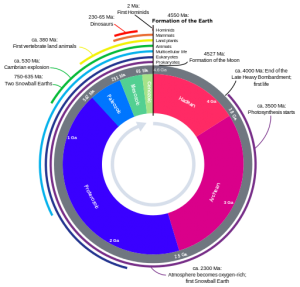The 4.54 billion-year history of the earth is divided into many subdivisions: eons, eras, periods, epochs, and ages with each division representing a smaller chunk of geologic time. If you are a parent of a young child and you happen to have viewed several episodes of the children’s educational program Dinosaur Train, you are probably familiar with the Mesozoic Era and the Triassic, Jurassic and Cretaceous periods.
Geologic history is recorded in rocks—layer upon layer accumulates, each layer revealing the geological, ecological and biological events that occurred over the time period that it was deposited. These geologic records tell us about the plants and animal life that could be found hundreds, thousands or millions of years ago. The minerals and chemicals of the rocks can tell us about climate, and sudden changes in the rock layers can tell us about sudden changes on earth.
Many natural forces have shaped the Earth that we know today. Bombardment from extra-planetary objects has left craters and correlate mass extinction events in the geologic record (1). Oceans once covered areas that are now prairies, where if you look long enough or deep enough you might just find a fossil of a previously unknown fish (2). Wind has shaped the earth by eroding and depositing soil. The Loess Hills of western Iowa, USA, (3) and the Loess Plateau of China (4) are two examples of wind-created land forms each created by the slow, wind-driven deposition of soil particles. Of course, water too, is a major force for creating canyons and gorges. The Indus River in Asia, for instance, has been estimated to deepen its course between 2 and 12mm/year in the gorge areas and is capable of removing blocks of rocks measuring up to 70cm (5), and the Grand Canyon in the United States was formed by the erosive power of the Colorado River (6).
So clearly, the forces of Nature on Earth and the occasional meteor from space have played major roles in shaping the Earth that we climb, dive, hike, bike and stroll on today. However, is Nature still the major force at working shaping the Earth? Or is the human species assuming that role?
Continue reading “Welcome to the Anthropocene? Only a Retrospective Analysis Will Tell”
